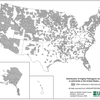Albany County calls on residents to submit their own redistricting plans
— Map from Albany County
This map shows current district lines in Albany County along with population deviations derived from the 2020 census. State law mandates that districts cannot have a difference in population of more than 5 percent, so the positive-negative deviation values for each district should not exceed 2.5 percent of the ideal total population of 8,105.
ALBANY COUNTY — For this decade’s county redistricting process, residents can do more than just share their desires for their districts — they can share their own proposed maps, too.
The Albany County Redistricting Commission is calling on Albany County residents to create their own district maps using the software Maptitude, which is expected to be made available to the public through the county website next week, Marie Allen Campbell, one of six commissioners on the Majority Minority Redistricting Subcommittee, told The Enterprise.
Residents will have at least through May to submit their maps, she said.
Through Maptitude, users can view existing district lines and the census blocks that comprise them, along with data about each. The goal is to create districts that conform to legal as well as community standards.
New York State Law holds, among other things, that there should not be a population difference of more than 5 percent between districts, capping positive and negative deviations from the ideal population total of 8,105 at t 2.5 percent.
Existing deviations allow residents to anticipate which districts are apt to change the most on that basis alone.
For instance, District 32, which covers the southern portion of Guilderland, has a negative deviation of roughly 6 percent. So, if the only goal is to balance the population of this district and the ones surrounding it, it would make the most sense to move parts of Districts 29 and 12, which border District 32 and have positive deviations of about 1.4 and 2.1, respectively, into District 32.
But there’s more to districts than population.
The commission expressed at a public hearing held earlier this month that what it wants most from residents is to hear about “communities of interest,” which are communities that are unified by at least one common value. A hamlet would be an example of a community that might prefer to stick together so its residents can more potently lobby for their interests.
Because communities of interest can be defined by myriad qualities, they can sometimes be invisible from census data or maps, which is why the commission is hoping for public input.
After the 2010 census, the county legislature in the spring of 2011 voted, 22 to 14, to accept the map submitted by a seven-member redistricting committee — the GOP minority of eight voted solidly for the plan while the Democrats were divided — that divided the Hilltowns.
Dozens of Hilltown residents had asked the legislature to maintain District 39, which had included Berne, Knox, and Rensselaerville and been represented by Alexander Gordon since 1996.
At the March public hearing, Patricia Sibilia, a commissioner with the Albany County Redistricting Commission, pointed out that Princeton University hosts a software called Representable, which lets people map out their own communities that can then be shared with the commission.
“You don’t need to know anything about redistricting,” Sibilia said. “It will walk you through and allow you, as well as any other people you want to work together in your community, draw maps of communities of interest, and then it very easily will allow you to export those and to send them into us, because communities of interest are the backbone of really good redistricting.”
Another factor that the commission will need to consider is the grouping of minority populations, whose powers as voting blocs are protected by state law.
To further ensure that minority-group interests are looked after at the beginning of the process, as opposed to through a court challenge, such as those brought forth in each of the last three redistricting processes, the Redistricting Commission is aided by the Majority Minority Redistricting Subcommittee, made up of six Black commissioners who will offer “a laser focus to ensure the fair representation of Albany County minority communities in all aspects of the redistricting process,” according to county law.
Albany County is using an independent commission is made up of nine unpaid commissioners, in addition to those on the subcommittee, all of whom have no formal political involvement.
A similar tactic was employed by the state this year, but the state committee was unable to agree on a single map, instead presenting two maps to the legislature, one created by the Democratic commissioners and the other by the Republican commissioners. The Democrat-dominated legislature went forward with the Democratic map, which is being challenged in court by Republicans.



